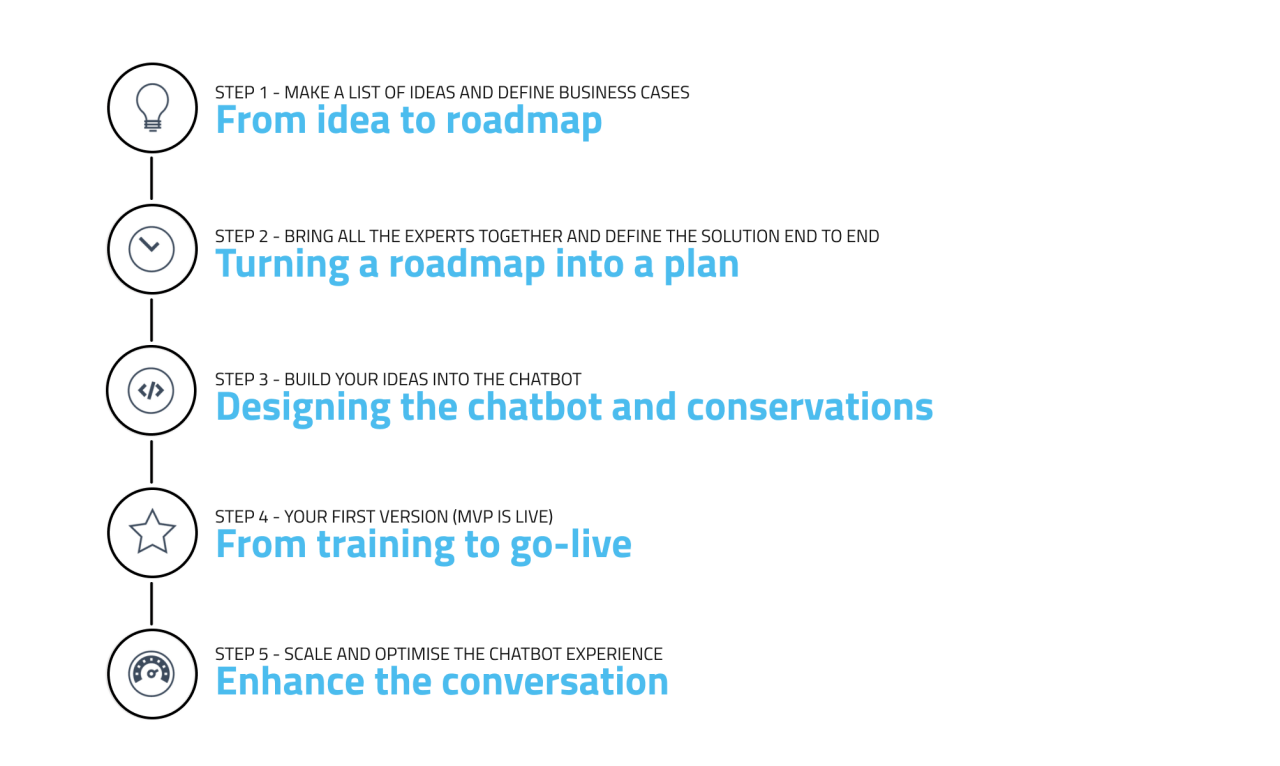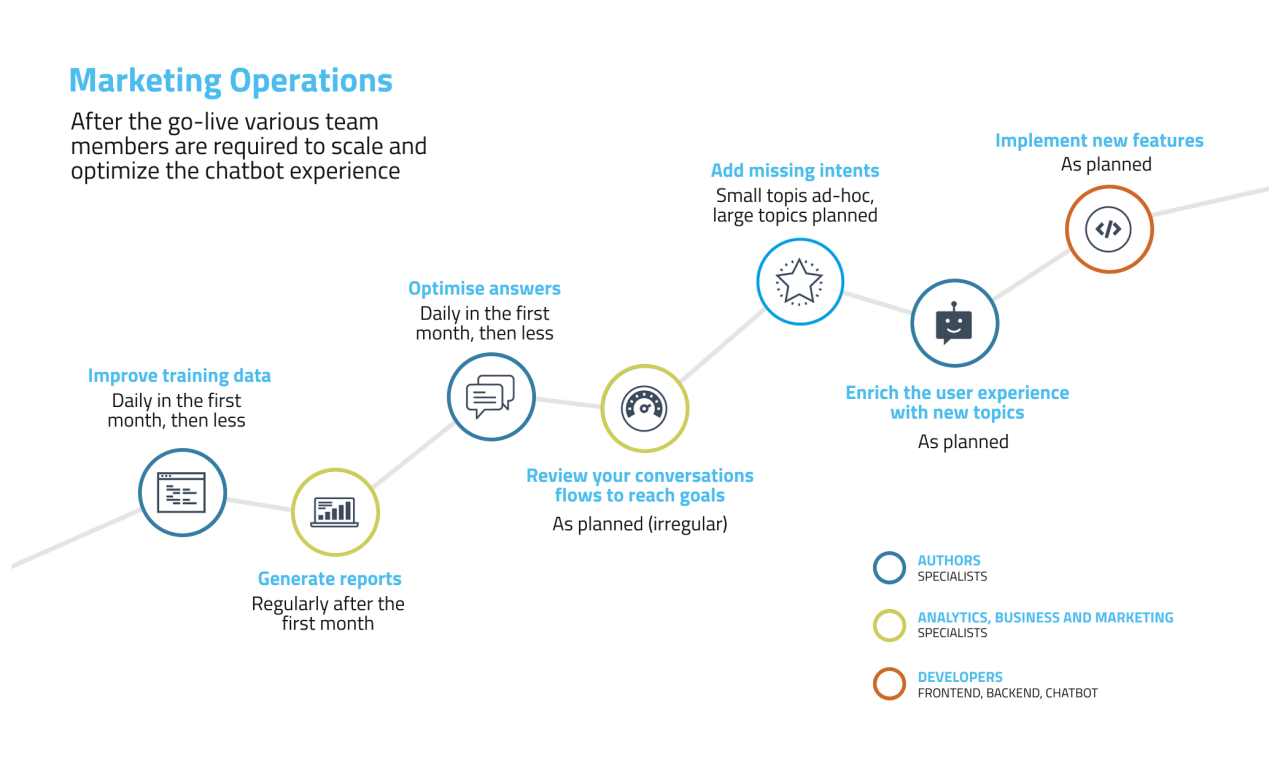Chatbot solutions are a flexible approach to connecting with customers in many situations.
They simplify access to your brand for your customers. Plus, they help you gain deep insights into your customers’ needs.
However, a chatbot is only successful when it manages to answer customer requests.
To reach this goal, optimizations after go-live are key.
In this post, we will explain the chatbot lifecycle and the five things you can do to improve your solution over time.
Finally, we will explain the effort your marketing team needs to invest for your solution to be successful.
What is the lifecycle of a chatbot?
We divide the chatbot lifecycle into the following five phases:
- From ideas to roadmap: First, you have to understand what chatbot solutions have to offer and define your vision.
- Turning a roadmap into a plan: Once your vision and strategy are defined, you will make a concrete plan to build your chatbot.
- Build chatbot and conversations: Implement, create content, and design conversations and begin training your system
- From training to go-live: You need to test your system, prepare the go-live, and bring your chatbot to life.
- Scale and optimize the chatbot experience: Go-live is just the start for your chatbot. Now it’s time to grow and optimize! Customers are impatient – don’t plan to optimize your chatbot in the future, do it continuously, from day one.
We will focus on the last step of the lifecycle, which is often misunderstood or put aside.

Do I really need to optimize an AI chatbot?
Chatbots use AI to perform.
Why is continuous optimization required? Current systems offer a flexibility in understanding the intention of the user.
However, if the language derivatives too much from the expected (trained) phrases and/or the intention is not known, the system reaches its limits.
Chatbot systems are not fully self-learning. You must assist them for them to improve.
The chatbot’s answers are not yet driven by AI at all. It’s typically driven by hand-crafted content which is optimized for the expected/wanted user journey instead.
Following challenges will occur for each chatbot over time – independent of how well you planned it:
- The user’s language is unexpected and therefore a wrong intention is assumed.
- Customers have questions concerning your business which you have not foreseen.
- You offer new services which the chatbot wasn’t trained for.
- Your chatbot system should get smarter with the integration of further systems, e.g., from a CRM or PIM
- The world we live in changes over time. This can force you to adapt to keep offering a pleasing and up to date experience for your customers – even though your services hasn’t changed.
So what are the concrete steps to keep your chatbot up to date?
How do you optimize a chatbot?
Optimization of a AI chatbot is crucial, and we have listed some activities that your marketing team will have to take care of, with some support from your IT team.
1 – Understanding more and more questions
Likely you started with a limited basis for natural language understanding. To understand any needs from your customers – independent of if you answer them or not – you will have to add more and more intents over time.
In short: You have to teach your system new phrases.
2 – Keeping your content up to date
As you optimize the content on your website over time, the same is required for your chatbot. Change wordings, influence the user journey, or improve linked assets.
In short: You have to optimize chatbot answers continuously.
3 – Learn from your customers
Your customers offer deep insights into their needs. Benefit from it.
To do so, monitor how they interact with your system and which questions they ask – especially for topics that you do not answer with your chatbot or even your website yet.
In short: You must monitor chatbot interactions to gain insights.
4 – Validate the success of your chatbot
Chatbots are awesome. They support your customers and can have a great return on investment.
However, don’t just believe that your chatbot is successful. Track if the intended goals are reached and try to collect additional data to identify further goals.
Set your success factors in relation to other systems and identify cross-system benefits.
In short: You have to monitor the success of your chatbot.
5 – Move your chatbot to the next level
Likely you restricted the list of features for your initial chatbot.
After go-live and having first experience with conversational marketing, it’s absolutely the right time to introduce additional features to your chatbot.
For example you could integrate further business information systems, try out new UX/UI concepts, or close feature gaps.
You should also make sure you stay up to date with features offered by your competitors’ chatbots.
In short: You have to enrich your chatbot with features to continue to benefit and stay attractive for customers.
Who optimizes the chatbot and how often?
For successful chatbot optimization, a proper process is required.
Identify the regular tasks and assign responsibilities. Plan optimization reviews to ensure success in the long run.
We described the main tasks earlier. They include:
- Increasing training data for existing intents
- Add new intents for unexpected topics
- Improve the flow and content of answers

All these tasks are mainly content-driven. Therefore, the maintenance must be driven by the business stakeholder and its team.
Team members must be trained to write content for chatbots and must understand the basic principles of NLU (Natural Language Understanding) to improve training data.
As these tasks impact customers directly it’s important to do them regularly. Improve and add intents e.g., once a week and update content monthly.
Beside chatbot specific maintenance tasks, other optimizations are needed as well : bug fixes and new features.
These tasks are typically solved in collaboration with the development team. Business stakeholders know what they want, developers know how to implement. Don’t just wait until you need features but plan regular improvements.
Lastly, ensure your system keeps its technology up to date. APIs may change and provide new features.
In summary, optimization must be planned, responsibilities assigned, and tasks distributed to team members.
Get the most out of your chatbot
A chatbot is a great tool to open another channel for your customers. It’s not a replacement but an additional opportunity to offer the best service.
It offers you deep insights into customers’ needs.
On top of that, it forces you to rethink your processes and goals for service and marketing tasks. Take the opportunity and improve your services with a conversational channel.
We summarized all aspects of the journey to a successful chatbot here (Whitepaper).
From the first vision, over planning, to go live. Find out more about chatbots and how they benefit your customers and your organization.


 Facebook
Facebook
 X
X
 Linkedin
Linkedin
